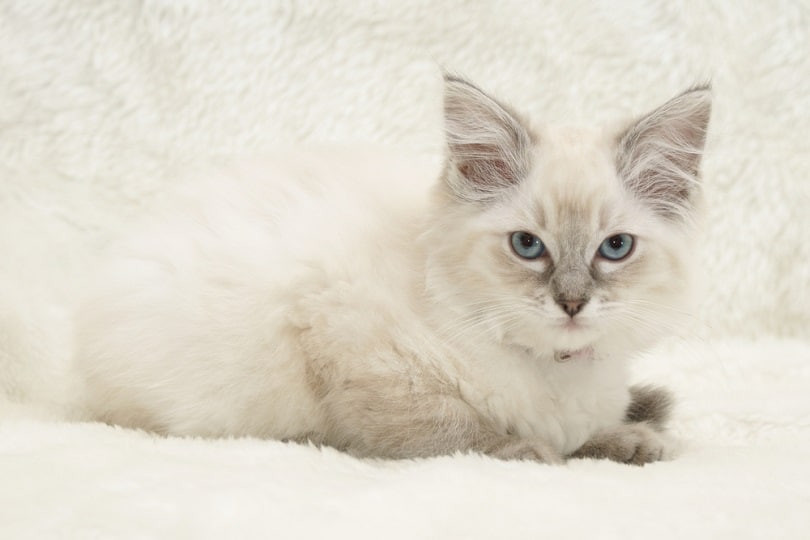Ragdoll cats, celebrated for their striking blue eyes, semi-long silky coats, and affectionate temperaments, have rapidly ascended the ranks of popular cat breeds. Their docile and gentle nature makes them ideal companions for families, seniors, and individuals alike. However, a common question arises for prospective cat owners, especially those with allergies: Are Ragdoll Cats Hypoallergenic? Understanding the reality of cat allergies and how it relates to Ragdolls is crucial before welcoming one of these beautiful felines into your home.
It’s a widespread misconception that certain pet breeds are entirely “hypoallergenic,” implying they cause no allergic reactions. In reality, the term “hypoallergenic” in pets means they produce fewer allergens compared to other breeds, not that they are allergen-free. When it comes to cats, the primary culprit behind allergies isn’t cat hair itself, but a protein called Fel d 1. This protein is predominantly found in cat saliva.
When cats groom themselves, they deposit saliva onto their fur and skin. As the saliva dries, it becomes airborne along with dander (dead skin flakes). These tiny, allergen-laden particles can then be inhaled, triggering allergic reactions in sensitive individuals. Therefore, the amount of Fel d 1 a cat produces is a more significant factor in allergies than the length or type of their fur.
 Playful Ragdoll kitten with blue eyes sitting on a wooden floor.
Playful Ragdoll kitten with blue eyes sitting on a wooden floor.
Understanding Cat Allergies: Are You Allergic?
Before you set your heart on a Ragdoll, it’s essential to determine if you or anyone in your household is allergic to cats. Cat allergy symptoms can vary widely in severity, from mild discomfort to significant respiratory issues, depending on individual sensitivity and the allergen levels present.
Common symptoms of cat allergies include:
- Respiratory Issues: Runny or congested nose, sneezing, coughing, wheezing, chest tightness, and shortness of breath.
- Skin Reactions: Hives or skin rashes, often after contact with a cat.
- Eye Irritation: Red, itchy, or watery eyes.
- Nasal Congestion: Leading to discomfort and potential sinus issues.
If you experience any of these symptoms when around cats, it’s advisable to consult an allergist for proper testing and diagnosis. Knowing your allergy status will help you make an informed decision about pet ownership and take necessary precautions.
Ragdoll Cats and Allergen Production
While Ragdolls are often mistakenly considered hypoallergenic, it’s important to clarify: Ragdoll cats are not hypoallergenic. They produce the Fel d 1 protein, just like other cat breeds. However, Ragdolls possess a unique coat characteristic that sometimes leads to this misconception. Unlike many other long-haired breeds, Ragdolls have a single-layer coat with minimal undercoat. This means they tend to shed less fur than cats with dense double coats.
Reduced shedding can lead to a decrease in the amount of hair and dander dispersed into the environment, potentially lowering overall allergen levels in a home. However, it’s crucial to remember that less shedding does not equate to less allergen production. Ragdolls still groom themselves and produce Fel d 1 in their saliva, which is the primary allergen.
Managing Allergies When Living with a Ragdoll
For individuals with mild cat allergies who are determined to welcome a Ragdoll into their lives, there are several effective strategies to minimize allergic reactions and create a more comfortable living environment.
1. Regular Grooming: Consistent grooming is paramount for managing allergens. Brushing your Ragdoll cat multiple times a week, ideally two to three times, helps to remove loose hair and dander before they can spread around your home. This practice is especially important during shedding seasons like spring and fall.
 Regular grooming of a Ragdoll cat with a slicker brush to reduce shedding and allergens.
Regular grooming of a Ragdoll cat with a slicker brush to reduce shedding and allergens.
2. Create an Allergy-Friendly Home Environment:
- HEPA Air Purifiers: Invest in high-quality air purifiers equipped with HEPA filters. These filters effectively trap airborne allergens, including cat dander and Fel d 1 particles, significantly improving air quality. Place air purifiers in frequently used rooms, especially bedrooms.
- Frequent Cleaning: Regular cleaning is essential. Vacuum carpets and rugs frequently with a vacuum cleaner that has a HEPA filter. Dust furniture regularly, and consider using allergen-reducing cleaning products. Wash bedding, curtains, and pet beds frequently to remove accumulated allergens.
- Limit Bedroom Access: Consider making your bedroom an allergy-free zone by preventing your Ragdoll from entering. Bedrooms often contain fabrics that trap allergens, and limiting cat access can reduce nighttime allergy symptoms.
- Hard Flooring: If possible, opt for hard flooring like wood, tile, or laminate instead of carpets, as hard surfaces are easier to clean and don’t trap allergens as readily as carpets.
3. Consult with Your Allergist and Veterinarian:
- Allergy Management Strategies: Discuss allergy management options with your allergist. They may recommend antihistamines, nasal corticosteroids, or other medications to help control your allergy symptoms. In some cases, allergy immunotherapy (allergy shots) might be considered.
- Veterinary Advice: Consult your veterinarian about strategies to potentially reduce Fel d 1 production in your Ragdoll. While there’s no guaranteed method to eliminate Fel d 1, some dietary supplements or specialized cat foods are marketed as potentially reducing allergen levels. However, scientific evidence supporting these claims is still evolving, and it’s essential to discuss these options with your vet.
Conclusion: Ragdolls and Allergies – Managing Expectations
While the gentle and beautiful Ragdoll cat is not a hypoallergenic breed, their lower shedding tendency compared to some long-haired cats can be a slight advantage for allergy sufferers. However, it’s crucial to understand that Ragdolls do produce allergens, and individuals with cat allergies may still experience symptoms.
By implementing diligent allergy management strategies, such as regular grooming, creating an allergy-conscious home environment, and consulting with healthcare professionals, many people with mild to moderate cat allergies can successfully live with and enjoy the companionship of a Ragdoll cat. Responsible pet ownership involves understanding the realities of pet allergies and taking proactive steps to ensure the well-being of both yourself and your feline companion.

